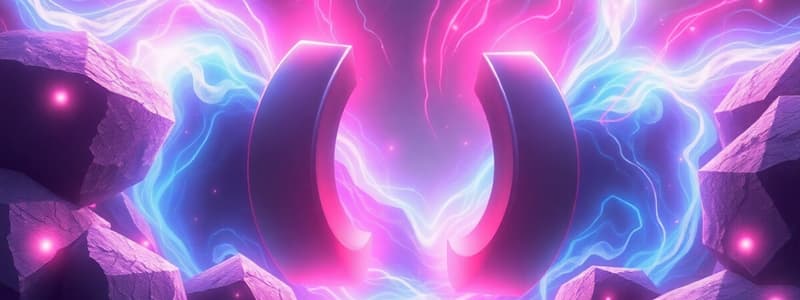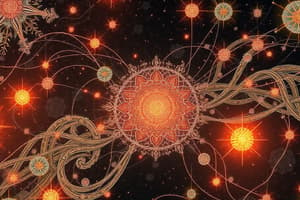Podcast
Questions and Answers
Why does a ball eventually stop rolling on the ground?
Why does a ball eventually stop rolling on the ground?
- Due to the air resistance slowing it down.
- Due to the force of gravity pulling it downwards.
- Because the ball loses its initial momentum.
- Because of the friction between the ball and the ground. (correct)
Which of the following is NOT a typical effect of applying a force to an object?
Which of the following is NOT a typical effect of applying a force to an object?
- Causing a stationary object to start moving.
- Changing the speed and direction of a moving object.
- Altering the shape and size of an object.
- Changing an objects color. (correct)
How do magnets contribute to the functionality of refrigerators?
How do magnets contribute to the functionality of refrigerators?
- They help keep the door tightly closed against the steel frame. (correct)
- They are used to control the compressor in the motor.
- They generate the cold temperature required for refrigeration.
- They power the internal lights of the refrigerator.
In what form do magnets operate within telephones and speakers to produce sound?
In what form do magnets operate within telephones and speakers to produce sound?
What is a primary characteristic of electromagnets?
What is a primary characteristic of electromagnets?
What are the two ends of a magnet called?
What are the two ends of a magnet called?
Which of the following is NOT considered a magnetic material?
Which of the following is NOT considered a magnetic material?
What happens when two south poles of different magnets are brought close to each other?
What happens when two south poles of different magnets are brought close to each other?
Which of these is an example of a natural magnet?
Which of these is an example of a natural magnet?
What term describes when a magnet pulls an object towards itself?
What term describes when a magnet pulls an object towards itself?
What material was initially used to create the first magnets?
What material was initially used to create the first magnets?
Which force is responsible for slowing down or stopping a moving object?
Which force is responsible for slowing down or stopping a moving object?
A man-made magnet can be made of what materials?
A man-made magnet can be made of what materials?
Flashcards
What is a magnet?
What is a magnet?
A special type of rock that attracts certain metals.
What are magnetic materials?
What are magnetic materials?
Materials like iron, nickel, cobalt, and steel that are attracted to magnets.
What are non-magnetic materials?
What are non-magnetic materials?
Materials like gold, silver, aluminum, copper, wood, paper, plastic, glass, and clay that are not attracted to magnets.
What are the poles of a magnet?
What are the poles of a magnet?
Signup and view all the flashcards
How do like poles of magnets interact?
How do like poles of magnets interact?
Signup and view all the flashcards
How do unlike poles of magnets interact?
How do unlike poles of magnets interact?
Signup and view all the flashcards
What is a force?
What is a force?
Signup and view all the flashcards
What is friction?
What is friction?
Signup and view all the flashcards
Friction
Friction
Signup and view all the flashcards
Force
Force
Signup and view all the flashcards
Magnetic Force
Magnetic Force
Signup and view all the flashcards
Electromagnets
Electromagnets
Signup and view all the flashcards
Electromagnet
Electromagnet
Signup and view all the flashcards
Study Notes
What is a Magnet?
- Magnets are special stones or man-made objects (iron/steel) that attract certain metals.
- Natural magnets, like magnetite, were discovered by a shepherd in Magnesia.
- Common shapes of man-made magnets include U-shaped, horseshoe, bar, rod, ring, and button magnets.
Magnet Interactions
- Magnets attract certain materials, called magnetic materials (iron, nickel, cobalt, steel).
- Non-magnetic materials are not attracted to magnets (gold, silver, aluminum, copper, wood, paper, plastic, glass, clay).
- Everyday examples of magnetic materials: nails, paper clips, and steel locks.
Magnet Poles
- Magnets have two poles: North (N) and South (S).
- The strongest magnetic force is at the poles, weakest in the center.
- Like poles (N-N or S-S) repel each other; unlike poles (N-S) attract each other.
Force and its Effects
- A force is a push or pull exerted between interacting objects.
- Forces can change an object's motion (speed, direction), stop it, or change its shape and size.
- Friction is a force that slows or stops movement.
Magnet Uses
- Magnets are in many everyday devices like telephones, headphones, speakers, computers, and video recorders.
- A refrigerator magnet attached to steel door keeps it closed tightly.
- Electromagnets are temporary magnets that work when electricity flows through them.
Studying That Suits You
Use AI to generate personalized quizzes and flashcards to suit your learning preferences.




